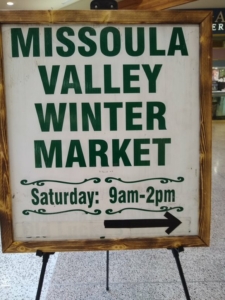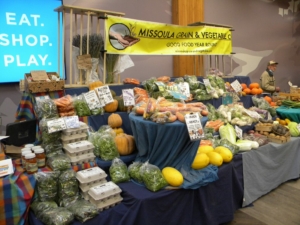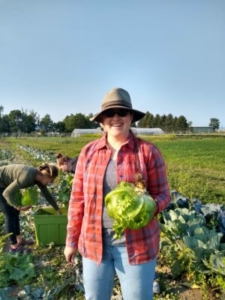Montana’s Winter Farmers Markets Help Provide Local Food Access and Bridge Revenue for Farmers
By Melissa Wyatt, Dietetic Intern, Montana State University
I am originally from southern Arizona where farmers markets are a year-round fixture—you can find everything from fresh chilis to value-added products such as homemade salsa. When I arrived at Montana State University in the summer of 2021, I dis

Missoula Valley Winter Market Sign
covered the Gallatin Valley Farmers Market. As summer came to a close, I figured farmers markets in Montana would also close. I was surprised to find that there are winter farmers markets here in Montana. Curious, I decided to explore the Missoula Valley Winter Market to learn more about how a winter market can be successful in Montana’s cold Northern climate.
The Missoula Valley Winter Market has been around for eight years. It hosts around 30 vendors offering baked goods, artisan goods, crafts, microbrew kombucha, and even fresh produce. I was in awe at the variety of goods available, including the vendors with fresh produce and eggs.
I visited with one of the produce vendors, Katelyn Madden of Missoula Grain and Vegetable Co., to ask how it is possible to bring fresh produce to a winter market. Katelyn, originally from the Eastern U.S., has experience growing produce in the winter months. So, when a winter market opened, she saw a great opportunity. Overall, Katelyn feels that being able to sell at a winter market is win-win. The winter market provides a year-round source of revenue, which enables Missoula Grain and Vegetable Co. to keep employees throughout the year. Katelyn does encourage producers to give producing and selling at a winter market a try, noting that it is a good place to get feedback from customers and determine production quantities.
According to James Keys, Farmers Market Support Specialist with Community Food

Missoula Grain & Vegetable at Missoula Valley Winter Market
and Agriculture Coalition, a Missoula-based food and farming organization, offering Double SNAP Dollars—Montana’s SNAP incentive program—has been a great boost to vendors and consumers alike. Customers on limited incomes can get more fresh, local foods and vendors see increased sales. Katelyn agrees, stating that her sales benefit from being at a market that offers Double SNAP Dollars.
The market also features “market tokens,” purchased by customers with a debit or credit card and then used to buy goods from vendors. This has been a win-win for both customers and vendors, allowing card-paying customers to purchase from vendors who are not able to process cards, and allowing vendors to focus on selling their products. Additionally, the token program can reduce the stigma for Double SNAP Dollar users who use coins to make purchases at the market. It was fascinating for me to learn about how this process works and how both vendors and customers benefit from it.
Overall, everyone I talked to agreed that good-quality, fresh, local foods abound at winter markets, supporting access to nutritious local food. Winter Markets are a great way for farmers to bridge their revenue through the winter months. The key is understanding how to produce a sellable product through the coldest darkest part of the winter. The vendors at the Missoula Valley Winter Farmers Market, through storage and season extension, have been able to

A photo of Melissa Wyatt in the field.
contribute to the abundance of fresh nutritious food through the winter months.
Related ATTRA Resource:
This blog is produced by the National Center for Appropriate Technology through the ATTRA Sustainable Agriculture program, under a cooperative agreement with USDA Rural Development. ATTRA.NCAT.ORG.
